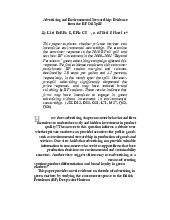










Preview text:
lOMoAR cPSD| 40799667
How Far Will International Economic Integration go
Advanced reading (Đại học Khoa học Xã hội và Nhân văn, Đại học Quốc gia Thành phố Hồ Chí Minh) lOMoAR cPSD| 40799667
American Economic Association
How Far Will International Economic Integration Go? Author(s): Dani Rodrik
Source: The Journal of Economic Perspectives, Vol. 14, No. 1 (Winter, 2000), pp. 177-186
Published by: American Economic Association
Stable URL: http://www.jstor.org/stable/2647061
Accessed: 08/05/2014 06:53
Your use of the JSTOR archive indicates your acceptance of the Terms & Conditions of Use, available at
http://www.jstor.org/page/info/about/policies/terms.jsp
JSTOR is a not-for-profit service that helps scholars, researchers, and students discover, use, and build upon a wide range of
content in a trusted digital archive. We use information technology and tools to increase productivity and facilitate new forms
of scholarship. For more information about JSTOR, please contact support@jstor.org.
American Economic Association is collaborating with JSTOR to digitize, preserve and extend access to
The Journal of Economic Perspectives. http://www.jstor.org lOMoAR cPSD| 40799667
Journal of EconomizicPerspectives-Volume 14, Numlber 1-Winter 2000-Pages 1 77-186
How Far Will International Economic Integration Go? Dani Rod:rik I
n a framouspassage from ThleEconomicConsequencesof thePeace,Keynes (1920)
drew a vivid picture of an integrated world economnyat the pinnacle of the
gold standard. While sippiIng his morning tea in bed, Keynes rerninisced
nostalgically, the Englishmnen of his timyiecould order by telephone various com-
modities of the world, invest in far-off places, purchase unlimnited aillounts of foreign
currency or precious metals, and arrange for initernatioinaltravel without even
requiring a passport. Keynes, who was wiritingin the aftermath of a devastating world
war and was anticipating a period of economic turbulen-ce and protection-ism-correctly,
as it turned out-con-sider-ed this a lost era of great magnificence.
Whlat will a latter-day Keynes, wiiting a centuly from now, say about today's
global economy with its unparalleled prosperity an-d integration (illustrated by
Figure 1)? Will she bemoan, as the original Keynes did, its collapse into disarrayand
autarky yet again? Or will she look back at the tail end of the 20th century as the
era that launched a new process of interrnationalization? Since ecoinomists rank
second only to astrologers in their predictive abilities, the correct answer is that we
have rio idea. The best that one canl do is speculate wildly, which is what I am about to do.
In these speculations, I will use the term "interniationaleconomnicintegration"
rather than "globalization," for two reasons. First, while not as trendy, my preferred
term has a distinct meaning that will be self-evident to economists. Globalization, by
contrast, is a term that is used in different ways by different analysts. Second, the term
"international economic initegration" does not come with the value judge-
a Dani Rodrik is Professor of International Political Econoly, John E Kennedy School of
Government, Harvard University, arid Research Associate, National Bureau of
Economic Research, both in Cambridge, iVlassachusetts. His e-mitail address is Kdani rodrik@harvard. edit). lOMoAR cPSD| 40799667
178 Journal of EconomicPerspectives Figure 1
World Exports/GDP (in 1990 constant dollars,percent) 16 - 14 - 12- 10- 8- - 6 4- 2O-
1820 1870 1900 1913 1929 1950 1960 1970 1980 1992
Source:Maddison (1995), Tables G-2, 1-4.
ments-positive or negative-that the term "globalization" seems to trigger in knee- jerk fashion.
How Much More Integration Could There Be?
The natural benchmark for thinking about international economic integration
is to consider a world in which markets for goods, services, and factors of produc-
tion are perfectly integrated. How far are we presently from such a world?
The answer is that we are quite far. Contrary to conventional wisdom and much
punditry, international economic integration remains remarkably limited. This
robust finding comes across in a wide range of studies, too numerous to cite here.'
National borders, such as the U.S.-Canadian one, seem to have a significantly
depressing effect on commerce, even in the absence of serious formal tariff or
nontariff barriers, linguistic or cultural differences, exchange rate uncertainty, and
other economic obstacles. International price arbitrage in tradable commodities
tends to occur very slowly. Investment portfolios in the advanced industrial coun-
tries typically exhibit large amounts of "home bias;" that is, people invest a higher
proportion of assets in their own countries than the principles of asset diversifica-
tion would seem to suggest. National investment rates remain highly correlated with
and dependent on national saving rates. Even in periods of exuberance, capital flows
between rich and poor nations fall considerably short of what theo-retical models
would predict. Real interest rates are not driven to equality even among advanced
countries with integrated financial markets. Severe restrictions on the international
mobility of labor are the rule rather than the exception. Even the 1
See in particular Feldstein and Horioka (1980) and Helliwell (1998). lOMoAR cPSD| 40799667 Dani Rodrik 179
Internet, the epitome of technology-driven internationalization, remains parochial in
many ways; for example, Amazon.com feels compelled to maintain a distinct British
site, Amazon.co.uk, with different recommendations and sales rankings than its American parent.
While formal barriers to trade and capital flows have been substantially re-
duced over the last three decades, international markets for goods, services, and
capital are not nearly as "thick"as they would be under complete integration. Why
so much trade in goods and capital has gone missing is the subject of an active
research agenda in international economics. The answers are not yet entirely clear.
But at some level there is no mystery. National borders demarcate political and
legal jurisdictions. Such demarcations serve to segment markets in much the same
way that transport costs or border taxes do. Exchanges that cross national jurisdic-
tions are subject to a wide array of transaction costs introduced by discontinuities in
political and legal systems.
These transaction costs arise from various sources, but perhaps the most
obvious is the problem of contract enforcement. When one of the parties reneges on
a written contract, local courts may be unwilling-and international courts unable-to
enforce a contract signed between residents of two different countries. Thus,
national sovereignty interferes with contract enforcement, leaving interna-tional
transactions hostage to an increased risk of opportunistic behavior. This problem is
most severe in the case of capital flows, and has the implication that national
borrowing opportunities are limited by the willingnzessof countries to service their
obligations rather than their ability to do so. But the problem exists generically for
any commercial contract signed by entities belonging to two differ-ing jurisdictions.2
When contracts are implicit rather than explicit, they require either repeated
interaction or other side constraints to make them sustainable. Both of these are
generally harder to achieve across national borders. In the domestic context, implicit
contracts are often "embedded" in social networks, which provide sanc-tions against
opportunistic behavior. One of the things that keeps businessmen honest is fear of
social ostracism. The role played by ethnic networks in fostering trade linkages, as in
the case of the Chinese in southeast Asia, is a clear indication of the importance of
group ties in facilitating economic exchange.3
Ultimately, contracts are often neither explicit nor implicit; they simply remain
incomplete. Laws, norms and customs are some of the ways in which the problem of
incompleteness of contracts is alleviated in the domestic sphere. To borrow an
example from Tirole (1989, pp. 113-114), what protects a consumer from the small
likelihood that a soda-pop bottle might explode is not a contingent contract signed
with the manufacturer, but that country's product liability laws. International law
2 See Anderson and Marcouiller (1999) for empirical eviclence which suggests that inadequate contract
enforcement imposes severe costs on trade.
3 Casella and Rauch (1997) were the first to emphasize the importanice of group ties in international
trade, using a model of differentiated produicts. lOMoAR cPSD| 40799667
180 Journal of Economic Perspectives
provides at best partial protection against incomplete contracts, and international
norms and customs are hardly up to the task either.
This line of argument has important implications for the question of how far
international economic integration will go. If the depth of markets is limited by the
reach of jurisdictional boundaries, does it not follow that national sovereignty
imposes serious constraints on international economic integration? Can markets
become international while politics remains local? Or, to ask a different but related
question, what would politics look like in a world in which international markets had
nothing to fear from the narrower scope of political jurisdictions? The rest of the
paper will advance some answers to these ques-tions, and in so doing lay out a
framework for thinking about the future of the world economy.
Caught in an International Trilemma
A familiar result of open-economy macroeconomics is that countries cannot
simultaneously maintain independent monetary policies, fixed exchange rates, and
an open capital account. This result is fondly known to the cognoscenti as the
"impossible trinity," or in Obstfeld and Taylor's (1998) terms, as the "open-
economy trilemma." The trilemma is represented schematically in the top panel of
Figure 2. If a government chooses fixed exchange rates and capital mobility, it has to
give up monetary autonomy. If it wants monetary autonomy and capital mobility, it
has to go with floating exchange rates. If it wants to combine fixed exchange rates
with monetary autonomy (at least in the short run), it had better restrict capital mobility.
The bottom panel of Figure 2 suggests, by analogy, a different kind of tri-
lemma, one that we might call the political trilemma of the world economy. The three
nodes of the extended trilemma are international economic integration, the nation-
state, and mass politics. I use the term "nation-state" to refer to territorial-
jurisdictional entities with independent powers of making and administering the law.
I use the term "mass politics" to refer to political systems where: a) the franchise is
unrestricted; b) there is a high degree of political mobilization; and c) political
institutions are responsive to mobilized groups.
The implied claim, as in the standard trilemma, is that we can have at most two
of these three things. If we want true international economic integration, we have to
go either with the nation-state, in which case the domain of national politics will
have to be significantly restricted, or else with mass politics, in which case we will
have to give up the nation-state in favor of global federalism. If we want highly
participatory political regimes, we have to choose between the nation-state and
international economic integration. If we want to keep the nation-state, we have to
choose between mass politics and international eco-nomic integration.
None of this is immediately obvious. But to see that there may be some logic lOMoAR cPSD| 40799667
Holw Far Will International Economic Integration Go? 181 Figure 2 Pick Two, Any Two StandardTrilernnma Capital mobility Gold Floating standard xchange rates Fixed exchange rates Monetaiy autonomy Bretton Woods AugmentedTrilemma
Integrated national economies Golden Global straitjacket federalism Nation state Mass politics Bretton Woods compromise
in it, consider our hypothetical perfectly integrated world economy. This would be a
world economy in which national jurisdictions do not interfere with arbitrage in
markets for goods, services or capital. Transaction costs and tax differentials would
be minor; convergence in commodity prices and factor returns would be almost
complete. The most obvious way we can reach such a world is by instituting
federalism on a global scale. Global federalism would align jurisdictions with the
market, and remove the "border" effects. In the United States, for example, despite
the continuing existence of differences in regulatory and taxation practices among
states, the presence of a national constitution, national government, and a federal
judiciary ensures that markets lOMoAR cPSD| 40799667
182 Journal of Economic Perspectives
are truly national.4 The European Union, while very far from a federal system at
present, seems to be headed in the same direction. Under a model of global
federalism, the entire world-or at least the parts that matter economically-would be
organized along the lines of the U.S. system. National governments would not
necessarily disappear, but their powers would be severely circum-scribed by
supranational legislative, executive, and judicial authorities. A world government
would take care of a world market.
But global federalism is not the only way to achieve complete international
economic integration. An alternative is to maintain the nation-state system largely
as is, but to ensure that national jurisdictions-and the differences among
them-do not get in the way of economic transactions. The overarching goal of
nation-states in this world would be to appear attractive to international markets.
National jurisdictions, far from acting as an obstacle, would be geared towards
facilitating international cominerce and capital mobility. Domestic regulations and
tax policies would be either harmonized according to international standards, or
structured such that they pose the least amount of hindrance to international
economic integration. The only local public goods provided would be those that are
compatible with integrated markets.
It is possible to envisage a world of this sort; in fact, many commentators seem
to believe we are already there. Governments today actively compete with each
other by pursuing policies that they believe will earn them market confidence and
attract trade and capital inflows: tight money, small government, low taxes, flexible
labor legislation, deregulation, privatization, and openness all around. These are the
policies that comprise what Thomas Friedman (1999) has aptly termed the Golden Straitjacket.
The price of maintaining national jurisdictional sovereignty while markets
become international is that politics have to be exercised over a much narrower
domain. Friedman notes (1999, p. 87):
As your country puts on the Golden Straitjacket, two things tend to happen:
your economy grows and your politics shrinks....
[The] Golden Straitjacket
narrows the political and economic policy choices of those in power to
relatively tight parameters. That is why it is increasingly difficult these days to
find any real differences between ruling and opposition parties in those
countries that have put on the Golden Straitjacket. Once your country puts on
the Golden Straitjacket, its political choices get reduced to Pepsi or Coke-to
slight nuances of tastes, slight nuances of policy, slight alterations in design to
account for local traditions, some loosening here or there, but never any major
deviation from the core golden rules.
Whether this description accurately characterizes our present world is debat-
4 However, Wolf (1997) finds that state borders within the United States have some deterrent effect on trade as well. lOMoAR cPSD| 40799667 Dani Rodrik 183
able. But Friedman is on to something. His argument carries considerable force in a
world where national markets are fully integrated. In such a world, the shrinkage of
politics would get reflected in the insulation of economic policy-making bodies
(central banks, fiscal authorities, and so on) from political participation and debate,
the disappearance (or privatization) of social insurance, and the replace-ment of
developmental goals with the need to maintain market confidence. The essential
point is this: once the rules of the game are set by the requirements of the global
economy, the ability of mobilized popular groups to access and influence national
economic policy-making has to be restricted. The experience with the gold standard,
and its eventual demise, provides an apt illustration of the incompatibil-ity: by the
interwar period, as the franchise was fully extended and labor became organized,
national governments found that they could no longer pursue gold standard economic orthodoxy.
Note the contrast with global federalism. Under global federalism, politics need
not, and would not, shrink: it would relocate to the global level. The United States
provides a useful way of thinking about this: the most contentious political battles in
the United States are fought not at the state level, but at the federal level.
Figure 2 shows a third option, which becomes available if we sacrifice the
objective of complete international economic integration. I have termed this the
Bretton Woods compromise. The essence of the Bretton Woods-GATT regime was
that countries were free to dance to their own tune as long as they removed a
number of border restrictions on trade and generally did not discriminate among
their trade partners.5 In the area of international finance, countries were allowed
(indeed encouraged) to maintain restrictions on capital flows. In the area of trade,
the rules frowned upon quantitative restrictions but not import tariffs. Even though
an impressive amount of trade liberalization was undertaken during successive
rounds of GATT negotiations, there were also gaping exceptions. Agriculture and
textiles were effectively left out of the negotiations. Various clauses in the GATT (on
anti-dumping and safeguards, in particular) permitted countries to erect trade
barriers when their industries came under severe competition from imports. De-
veloping country trade policies were effectively left outside the scope of interna- tional discipline.6
Until roughly the 1980s, these loose rules left enough space for countries to
follow their own, possibly divergent paths of development. Hence, western Europe
chose to integrate within itself and to erect an extensive system of social insurance.
Japan caught up with the developed economies using its own dis-tinctive brand of
capitalism, combining a dynamic export machine with large
5Ruggie (1994) has written insightfully on this, describing the system that emerged as "embedded liberalism."
6 Lawrence (1996) has termed the model of integration followed under the Bretton Woods-GATT system
as "shallow integration," to distinguish it from the "deep integration" that requires behind-the-border
harmonization of regulatory policies. lOMoAR cPSD| 40799667
184 Journal of Econonmic Perspectives
doses of inefficiency in services and agriculture. China grew by leaps and bounds
once it recognized the importance of private initiative, even though it flouted every
other rule ini the guidebook. Much of the rest of east Asia generated an economic
miracle relying on industrial policies that have since been banned by the World
Trade Organization. Scores of countries in Latin America, the Middle East, and
Africa generated unprecedented economic growth rates until the late 1970s under
import-substitution policies that insu-lated their economies from the world economy.
The Bretton Woods compr-omise was largely abandoned in the 1980s, for
several reasons. Improvements in com-munication and transportation technologies
undermined the old regime by making international economic integration easier.
International trade agreernents began to reach behind national borders; for exam-
ple, policies on antitrust or health and safety, which had previously been left to
domestic politics, now became issues in international trade discussions. Finally, there
was a shift in attitudes in favor of openness, as many developing nations came to
believe that they would be better served by a policy of openness. The upshot is that
we are left somewhere in between the three nodes of the augrnented trilemma of
Figure 2. Which one shall we eventually give up? Where Next?
I have argued so f'arthat we are presently nowhere near complete international
economic integration, and that traveling the remiaining distance will require either
an expansion of our jurisdictions or a shrinkage of our politics. Now I have to stick
my neck out farther and make a prediction.
I would place my bet on global federalism, as unlikely as that may seem at the
nioment. In the next 100 years or so, I see a world in which the reach of markets,
jLurisdictions,and politics are each truly and commensurately global as the most
likely outcome.7 I may also be biased, since that is the option that I personally like best.
The bet is based on the following reasoning. First, continuing techniological
progress will both foster international economic integration and remnovesome of the
traditional obstacles (such as distance) to global government. Second, short of global
wars or natural disasters of mllajorproportionis, it is hard to envisage that a
substantial part of the world's population will want to give up the goodies that an
increasingly integrated (hence efficient) world miarketcan deliver. Third, hard-won
7I am purposefully vague about the specific form that global federalism might take, other than state that
it will entail much greater pcolitical centralization than tlhe current setup. See Frey (1996) on some
intriguLingideas for the design of federal political systems. See Bergsten (1993) for an alternative
scenario that combines political fragmentation-ratlher than centralization-with full international ecoinomic integration. lOMoAR cPSD| 40799667
How Far Will International EconomaicIntegration Go? 185
citizenship rights (of representation and self-government) are also unlikely to be
given up easily, keeping pressure on politicians to remain accountable to the wishes of their electorate.
The most dicey projection is that we shall see an alliance of convenience in favor
of global governance between those who perceive themselves to be the "losers" from
economic integration, like labor grou.ps and environmentalists, and those who
perceive themselves as the "winners," like exporters, multina-tional enterprises, and
financial interests. The alliance will be underpinned by the mutual realization that
both sets of interests are best served by the supra-national promulgation of rules,
regulations, and standards. Labor advocates and environmentalists will get a shot at
international. labor and environmental rules. Multina.tional enterprises will be able
to operate under global accounting standards. Investors will benefit from com.mon
disclosure, bankruptcy, and financial r-egulations. A global fiscal authority will
provide public goods and a global lender-of-last resort will sta.bilize the financial
system. Part of the bargain will be to make international policymakers accountable
through democratic elections, with due regard to the preeminence of the
economically more powerful countries. National bureaucrats and politicians, the
only remaining beneficiaries of the nation-state, will either refashion themselves as
global officials or they will be shouldered. aside.
Global federalism does not mean that the United Nations will turn itself into a
world government. What we are likely to get is a combination of traditional forms of
governance (an elected global legislative body) with regu-latory institutions
spanning multiple jurisdictions and accountable to perhaps multiple types of
representative bodies. In an age of rapid technological change, the form of
governance itself can be expected to be subject to considerable innovation.
Many things can go wrong with this scenario. One alternative possibility is that
an ongoing series of financial crises will leave national electorates suffi-ciently shell-
shocked that they willingly, if unhappily, don the Golden Strait-jacket for the long
run. This scenario amounts to the Argentinization of national politics on a global
scal.e. Another possibility is tha.t governments will resort to protectionism to deal
with the distributive and governance difficulties posed by economic integration. That
would be the backlash scenario. If I were making a prediction for the next 20 years
rather than 100, I would regard either one of these scenarios as more likely than
global federalism. But a longer time
horizon leaves room for greater optimism.
Now let me tell you about the Wars of Secession of 2120 ...
m I thank Brad De Long; Alan Krueger and Timothy Tacylorfor vety useful suggestions.
This content downloaded from 195.110.161.101 on Thu, 8 May 2014 06:53:48 AM lOMoAR cPSD| 40799667
186 Journal of Economic Perspectives References
Anderson, James E. and Douglas Marcouiller.
Keynes, John Maynard. 1920. The Economic
1999. "Trade, Insecurity, and Home Bias: An
Consequencesof the Peace. New York: Harcourt,
Empirical Investigation." NBER Working Paper Brace, and Howe. No. 7000, March.
Lawrence, Robert Z. 1996. Regionalism,Multi-
Bergsten, C. Fred. 1993. "The Rationale for a
lateralism, and Deeper Integration. Washington,
Rosy View: What a Global Economy Will Look
DC: Brookings Institution.
Like." TheEconomist.September 11.
Maddison, Angus. 1995. Monitoring the World
Casella, Alessandra and James Rauch. 1997.
Economy1820-1992. Paris: OECD.
"Anonymous Market and Group Ties in Interna-
Obstfeld, Maurice and Alan Taylor. 1998. "The
tional Trade." NBER Working Paper No.
Great Depression as a Watershed: Interna-tional W6186, September.
Capital Mobility over the Long Run," in The
Feldstein, Martin S. and Charles Horioka.
Defining Moment:The GreatDepressionand the
1980. "Domestic Saving and International Capi-
AmericanEconomyin the TwentiethCenturyBordo,.
tal Flows." EconomicJournal. June, 90, pp. 314-
Michael D., Claudia D. Goldin, and Eugene N. 29.
White, eds. Chicago: University of Chicago
Frey, Bruno. 1996. "FOCJ:Competitive Gov- Press, pp. 353-402.
ernments for Europe." International Reviewvof
Ruggie, John G. 1994. "Trade, Protectionism
Law and Econzomics16,. pp. 315-27.
and the Future of Welfare Capitalism."Journal
Friedman, Thomas L. 1999. The Lexus and the
of InternationalAffairs. Summer, 48:1, pp. 1-11. Olive
Tree:UnderstandingGlobalizationNew.
Tirole, Jean. 1989. The Theoryof Industrial Or-
York: Farrar, Straus and Giroux.
ganization. Cambridge, MA: MIT Press, 1989.
Helliwell, John F. 1998. How Much Do
Wolf, Holger C. 1997. "Patterns of Intra- and National
BordersMatter?Washington, DC:
Inter-State Trade." NBER Working Paper No.
Brookings Insti-tution. W5939, February.





